
an inquiry into the realm of the absurd led by CmcD
Allow me to begin with a little introduction to this exposé. I first delivered a speech on Mullets and their ill effects on society when I was a junior at Cornell University. I have now decided to reinvent the monologue and give it a second life at 1 Tuff Place. You may be asking, "CmcD, how dare you assume to know the intricacies of a culture as diverse and embarrassing as the Mulleted community?" Well, for your information, I just recently cut my own Hockey Hair and now feel 100% better, not to mention ten pounds lighter. Though the whole Mullet craze (or shall I say the wittiness of Mullet criticism) has come and gone, now occupying the same clichéd territory inhabited by the likes of Wayne Brady and nearly every reality TV show, I hope you can still enjoy the lack of respect I show towards an unknowing sect of Americana...
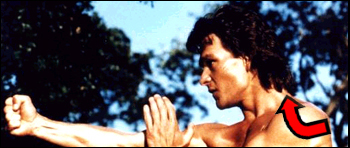 You've seen it before. You will see it again. I'm not talking about the further exploits of hotel heiresses and other no-talents or another former Predator star becoming an elected official (though I have heard rumblings of Carl Weathers promising political aspirations). I'm about to let loose on you the tale of the Mullet. Whether that is spelled T-A-L-E or T-A-I-L, I'll let you be the judge, for it does not matter.
You've seen it before. You will see it again. I'm not talking about the further exploits of hotel heiresses and other no-talents or another former Predator star becoming an elected official (though I have heard rumblings of Carl Weathers promising political aspirations). I'm about to let loose on you the tale of the Mullet. Whether that is spelled T-A-L-E or T-A-I-L, I'll let you be the judge, for it does not matter.
What is a Mullet you might ask? And if you were to ask you really haven't been watching enough Joe Dirt, Married...with Children reruns, or the Big Bass Fisherman Show (or been awake the past three years…obviously, this opening was a lot more effective when first given as a speech). Aside from being a salt water fish found inshore, a Mullet is the hairstyle that was all the rage in the 80s, I'm sure even some of you were Mulletheads in your pre-Nirvana days. Though Mullets were huge in the 80s, they are still with us today. So sit back and relax, turn off that episode of Walker Texas Ranger on the moving picture box (television to us edumacated folks), and crack open a nice warm can of Miller High Life or, if you're a fancyboy, Pabst Blue Ribbon.
In the following I will chronicle the rise of the Mullet (or is it descent?), explain how to tell different Mullets apart, and finally, what the Mullet has to do with us as a people, a civilization, and a scared public. Throughout this composition I will refer to the Mullet in many egregious terms such as a Missouri Compromise, Neckwarmer, and/or Canadian Creation (I'll apologize in advance to our Mullet-inclined brothers and sisters to the north). So without further ado, enjoy this journey through Mulletdom.
 Coined by Beastie Boy Mike D in their 1995 song "Mullet Head", a classification now existed for all those of the hairstyle-impaired community. The song's chorus, "Cut the sides, don't touch the back" is the mantra for all Mullet Heads. In laymen's terms, the Mullet is a hybrid hairdo. Just as the Oreo incorporates the goodness of the cookie and Crisco, and Fred Durst combines the rugged street smarts of Vanilla Ice with the poetic lyrics of a young Lil Bow Wow, the Mullet is both corporate and carefree. It exhibits the long-haired style of the hippies along with the crew-cut trademark of the square community. Whoever once uttered, "You can't have your cake and eat it too" never witnessed a fully realized mudflap flowing past the collar of a frayed lumberjack flannel shirt.
Coined by Beastie Boy Mike D in their 1995 song "Mullet Head", a classification now existed for all those of the hairstyle-impaired community. The song's chorus, "Cut the sides, don't touch the back" is the mantra for all Mullet Heads. In laymen's terms, the Mullet is a hybrid hairdo. Just as the Oreo incorporates the goodness of the cookie and Crisco, and Fred Durst combines the rugged street smarts of Vanilla Ice with the poetic lyrics of a young Lil Bow Wow, the Mullet is both corporate and carefree. It exhibits the long-haired style of the hippies along with the crew-cut trademark of the square community. Whoever once uttered, "You can't have your cake and eat it too" never witnessed a fully realized mudflap flowing past the collar of a frayed lumberjack flannel shirt.
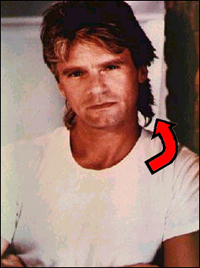 While the Mullet's modern rebirth can be traced back to the disco era, just as all the other seeds of embarrassing fashion trends were planted, the true modern Mullet, as we know it today, did not take form until the 1980s. All the indulgences of the disco days, cocaine-crazed nights, unprotected sex, and Rick James (also funnier before Chappelle claimed him as his own comedic tool), led to the creative hangover known as the 80s. As long-haired hippies, and their southern counterparts, the classic rockers, grew up and became "corporate," they searched for a way to hang onto their past carefree ways.
While the Mullet's modern rebirth can be traced back to the disco era, just as all the other seeds of embarrassing fashion trends were planted, the true modern Mullet, as we know it today, did not take form until the 1980s. All the indulgences of the disco days, cocaine-crazed nights, unprotected sex, and Rick James (also funnier before Chappelle claimed him as his own comedic tool), led to the creative hangover known as the 80s. As long-haired hippies, and their southern counterparts, the classic rockers, grew up and became "corporate," they searched for a way to hang onto their past carefree ways.
Thus, the genesis for the modern Mullet was formed. By leaving only the back long, they were able to tuck their manes into their suits during the week, but then could let it "hang loose" on the weekends at Wal-Mart shopping sprees and local carnivals. This is the basis for all Mullets, but just as we were reminded in Forrest Gump that there are many uses for shrimp, the Mullet is equally versatile and takes many forms. Unfortunately though, the Mullet dates back much further than the Beastie Boy's 1995 song...

Since the first mammal stepped out of prehistoric ooze thousands of years ago, the Mullet has been a chief concern of all hairy beings. Neanderthal man was plagued by the ever-menacing bewilderment of the Mullet. Virtually completely covered in hair, he knew that what was on top of his head was ghastly but, lacking any logical thought processes, didn't know what to do about it. One can hope that the cave paintings of Homo Erectus were a call for help, perhaps the first, and only, classified ad seeking a barber.
It is ironic that all the depictions of pre-Homo Sapiens are that of Mullet- sporting cavemen, but has anyone ever seen an ape with a Mullet? Are they truly lower on the evolutionary scale than humans and their immediate ancestors? Is it unfair to call the Mullet an ape drape? From all accounts apes coifed a high-and-tight similar to contemporary servicemen and have consistently done all they can to keep it nice and bug-free, unlike many in our species sporting filthy Tennessee Tophats.
Now that we know where the Mullet's been, lets see its modern form and where it's at now...
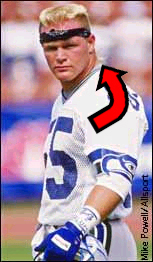
The Standard Bi-Level
The traditional Anglo Bible-belt cut, this hairstyle is arguably the most popular of Mullets. You can spot such a hairstyle in its natural state at places like Denny's, most areas of central New York, and in the music of most 80s adult contempo artists. Variations on the bi-level include:
The Spiked Bi-Level - popularized by such 80s icons as Brian Bosworth (pictured at left), this is achieved by spiking the trimmed portion (or upper level) of the Mullet while leaving the back to "blow in the breeze". Studies have been conducted on the propensity of those sporting spiked bi-levels to forgo promising pro-sports careers in favor of B-movie stardom. Thus far, results have been inconclusive.
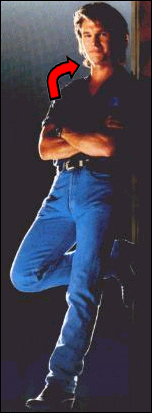 The Road House - aptly named after Patrick Swayze's often imitated but never replicated Mullet in the classic film Road House, essentially a tale of good and evil Mullets, with Swayze's Dalton-do prevailing in the end. An interesting side note; never again was Swayze able to sculpt his Mullet into the Road House form, thus forcing him to take a role in Ghost where he found himself entering the body of one Whoopi Goldberg, and speaking of Whoopi (or shall I say Jumping Jack Flash)...
The Road House - aptly named after Patrick Swayze's often imitated but never replicated Mullet in the classic film Road House, essentially a tale of good and evil Mullets, with Swayze's Dalton-do prevailing in the end. An interesting side note; never again was Swayze able to sculpt his Mullet into the Road House form, thus forcing him to take a role in Ghost where he found himself entering the body of one Whoopi Goldberg, and speaking of Whoopi (or shall I say Jumping Jack Flash)...
 The Poodle Cut
The Poodle Cut
Due to the Mullet's nondiscriminatory stance on race, the Poodle Cut is the favorite among the African-American hairstyle-impaired community. Most Poodle Cuts were technically Jheri-Curl Poodles, due to the over-saturation of the 80s-staple hair care product Jheri Curl hair activator, but for our purposes we'll just refer to them as standard Poodles. This style was popularized by such 80s greaseballs as Ice Cube, Michael Jackson (when he still had a nose and a clean criminal record), and the Soul Glo guy in Coming to America. But just as Elvis Presley succeeded in adapting the African-American musical style of rhythm and blues into what eventually became a lame White art form, Hollywood has succeeded in adapting the Poodle Cut...
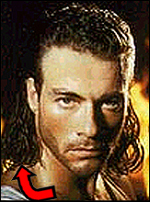 The French Poodle - Following in the paths of such Mullet-adorned action stars as Chuck Norris and Sylvester Stallone, Jean Claude Van Damme unleashed his Mullet on the world, forcing the public to take notice of the incredible dramatic range in both his acting AND Parisian Skunk-do. While Van Damme can be attributed with giving this cut its name, there have been many perpetrators before and after him. These Poodle-draped celebrities range from David Hasselhoff in his Michael Knight days, A.C. Slater whose hair was always in need of being saved by a bell or pair of scissors, and that lovable prankster turned evangelical acting/internet sensation Kirk Cameron from Growing Pains.
The French Poodle - Following in the paths of such Mullet-adorned action stars as Chuck Norris and Sylvester Stallone, Jean Claude Van Damme unleashed his Mullet on the world, forcing the public to take notice of the incredible dramatic range in both his acting AND Parisian Skunk-do. While Van Damme can be attributed with giving this cut its name, there have been many perpetrators before and after him. These Poodle-draped celebrities range from David Hasselhoff in his Michael Knight days, A.C. Slater whose hair was always in need of being saved by a bell or pair of scissors, and that lovable prankster turned evangelical acting/internet sensation Kirk Cameron from Growing Pains.
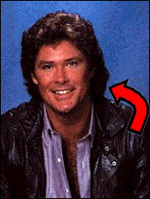
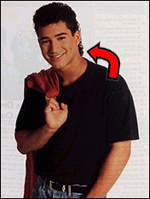
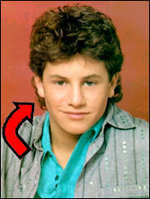

So now you'll hopefully be able to distinguish one Mullet from the next, who is still caught sporting these atrocious head ornaments? While it is far less likely to spot a Mullet in all its full-length glory, the Soccer Rocker is still prevalent anywhere George W. Bush receives a majority of votes and in factories throughout the land. Is it any wonder why all of their jobs are going overseas to Indians who at least have the decency to conceal their mullets under turbans? Though some may see it as a sign of our impending doom, it just goes to show that the Mullet is here to stay, whether we like it or not.
So for all of you out there, be it fans of unintentional comedy or true Mullet Heads, sing it with me, "We shall overcome...and cut the sides, don't touch the back!"


